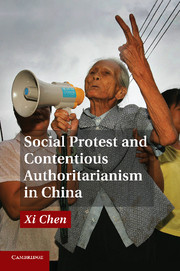Book contents
- Frontmatter
- Contents
- Figures and Tables
- Acknowledgments
- Part I A Contentious Society
- Part II Political Opportunity Structure
- 3 Market Reforms and State Strategies
- 4 The Xinfang System and Political Opportunity
- Part III Protest Strategies and Tactics
- Part IV Conclusion
- Appendix
- Bibliography
- Index
- References
4 - The Xinfang System and Political Opportunity
Published online by Cambridge University Press: 05 December 2011
- Frontmatter
- Contents
- Figures and Tables
- Acknowledgments
- Part I A Contentious Society
- Part II Political Opportunity Structure
- 3 Market Reforms and State Strategies
- 4 The Xinfang System and Political Opportunity
- Part III Protest Strategies and Tactics
- Part IV Conclusion
- Appendix
- Bibliography
- Index
- References
Summary
To explain the dynamics and strategic orientation of popular protests since the 1990s, we naturally look for factors of social and political change in the Reform Era. What have often been overlooked are some enduring elements of the regime that have also profoundly shaped popular collective action. This chapter will show how inherent contradictions of the PRC have played such an important role.
Such contradictions have been most clearly manifest in the xinfang system, one of the primary institutions for the CCP to handle popular claim-making activities. The design of this system is based on the mass line, which simultaneously emphasizes the concentration of political power to Party leaders and nonbinding consultation with the masses. As a consultative apparatus it has been designed to facilitate “managed participation,” which means that both the forms and effects of participation are under tight control by the Party-state. Ordinary people can signal their preferences to the state but are not supposed to exert pressure on it. It is up to state officials to decide how such preferences will influence policy making and implementation.
- Type
- Chapter
- Information
- Social Protest and Contentious Authoritarianism in China , pp. 87 - 132Publisher: Cambridge University PressPrint publication year: 2011
References
- 1
- Cited by

